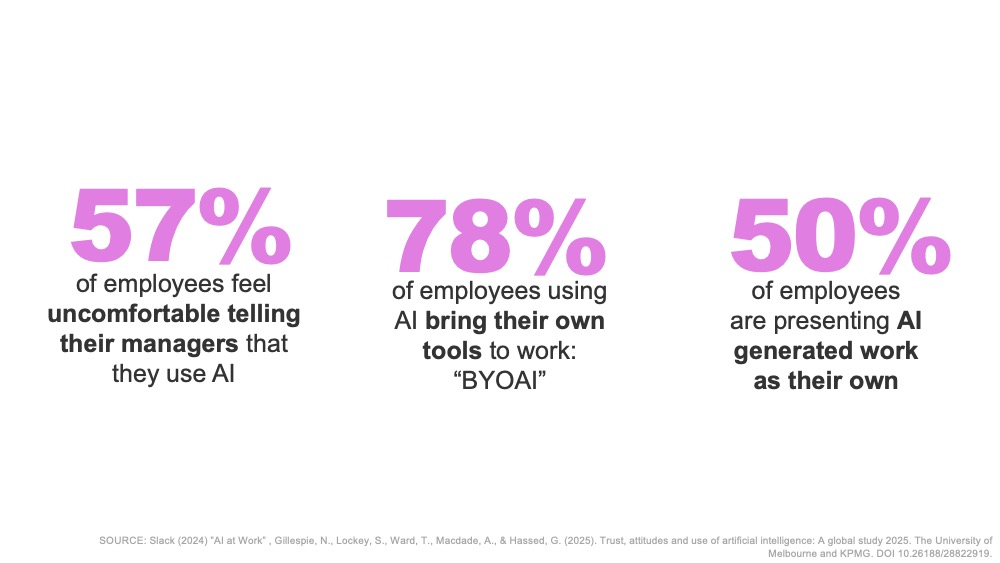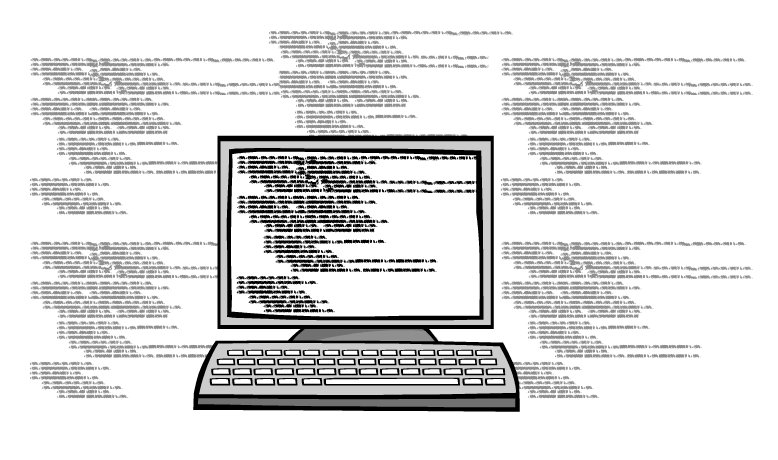A new approach to software development where anyone can use AI to generate working code just by prompting specs and goals in natural language. Vibe Coding is a laid-back yet powerful way to create small, personal tech solutions quickly, without needing to read or write every line of code. While it offers incredible speed and accessibility, Vibe Coding only “mostly works.” A guide to what it is, how to prompt for it, and the safe way to AI code without the need for 2am emergency Human test-and-debug sessions.
Fiona Passantino, AI Leadership
Feel the vibe
By now, most of us are happily generating text and images for our kids’ birthday parties, schedules for team meetings or help with that difficult conversation with our bosses. We might be flirting with voice activated bots, generating cloned voices or creating some looped video for our TikTok tutorial feeds.
But what many of us don’t know is that we also have the ability to generate functional code for nearly any platform on earth; whether it’s for an iPhone app, Python refinement layering or straight-up HTML for our legacy projects, AI is able to design, build and debug code, It even offer suggestions for usability, clean up existing code, or build better mobile interfaces.

What’s “Vibe Coding”?
“Vibe Coding” means using AI to write software applications in any programming language, by describing what you want in plain language, then testing and fixing it yourself. It’s the enlightened (or lazy) professional’s way of writing working tools that requires little or no coding abilities. Instead of typing out every line of code (or hiring someone to do so), you just prompt your brief; explain what you want for the platform you need, in natural, Human language.
The term was first used by Andrej Karpathy, one of Open AI’s Founding Fathers, in early 2025[i]. He was amazed to find that even the earliest iterations of ChatGPT could write software that “mostly worked”; a few Human tweaks and checks, and it was ready to ship[ii].
I decided to try this myself. In the old days, if there was something technical, I wanted to develop, I would have to find someone on Freelancer.com to build it. But within one hour of vibe coding, I had a new WordPress user tracker plug-in for my website, a daily Italian phrase generator in Java, and a cooler landing page for a legacy (ancient!) HTML index file.

How to prompt for code
The best way to prompt for code is to get clear on your brief; like all AI interactions, the more you know about what you want, what “done” looks like, and how you want it to be verified, the better. All effective prompting needs a good structure; a few tips for getting started.
1. Context
Context is the background story of your project; what problem you’re solving, who it’s for, and why it matters. It helps the AI understand your goal. Why are you building what you’re building? What is the problem you face? Who is the solution for? How will it be used?
“I’m building a tool to help my sales team track daily calls more easily because they’re wasting time updating multiple spreadsheets.”
“I need a small script to automatically rename downloaded Zoom recordings, so I can organize my files without doing it manually.”
2. Functionality
What does the software need to do? What will be running it (mobile, desktop)? Is it an underwater technical process that will never see the light of day, or will it be responsive to Human interaction? You can write this as a typical Agile user story: “As a <describe the user you have in mind>, I want to <describe the task your software will carry out> in order to <describe the result>.”
“As a project manager, I want to generate a weekly task summary from Jira so I can send updates to stakeholders.”
“As a language learner, I want a Chrome extension that shows me one new Italian word each time I open a new tab.”
3. Structure
Any deliverable from a wizard to a website, will need a structure. Structure describes the layout or wireframe of your idea. What does the user experience first, second and third during the journey through your tool, and what does each screen need to do?
“My app has a welcome screen, a search bar, then a list of results with images. Each result links to a detailed view with more info.”
“I want a one-page site with a hero section, a short ‘About’ section, a 3-column service grid, and a contact form in the footer.”
4. Design
The visual style – colors, fonts, mood, layout – which express the brand or function. Describe the look-and-feel; colors, style, fonts and amount of white space. Get familiar with words like “clean”, “professional”, “playful” or “bold”. Are you using splashy video backgrounds or a solid, single-color stripe? What appears on each page? Provide the wireframe in written form; header, sections, pages, gutter and footer details. Describe spacing and layout. If your AI helper allows, upload links or screenshots to provide examples.
“I want the app to look clean and modern with lots of white space, light blues and greys, and rounded buttons.”
“Make the site bold and playful, with bright colors, big fonts, and an animated background video at the top.”
5. Output format
Define the format and platform for your code, the minimum requirements. What is your software language? Python, R, or HTML? Is this an app for an iPhone or a desktop widget? Be clear about the deliverable you expect, and where it will eventually live.
“I need this script in Python to run as a scheduled task on Windows.”
“Create an HTML and CSS page for desktop and mobile browsers, no JavaScript needed.”
6. Test and de-bug protocol
Finally, the result will need to work; this is where you map out your steps for your test-and-de-bug roadmap. Naturally, you the Human will need to run this software and make sure it does what it needs to, try to “break” it and find the weak spots. But AI can provide another set of eyes.
It could be that you first, ask one model to test and de-bug, then do testing in a different tool (or two) for fresh perspective. Both Human and AI suffer from “original creator” syndrome and will often miss simple errors that a fresh tool might likely find. Ask another Human to test your code as well. A solid “Two-AI-Two-Human” test and de-bug lineup will give you a range of results and won’t harsh the vibe too much.
“First, I will test the code myself, then I will ask you to find any additional errors. Finally, I will give it to a colleague to test on a Samsung phone and tablet as well as iPhone and iPad.”
“I will paste the first draft into an internal de-bugger tool, and another AI model to catch bugs. Once those are fixed, I will run it through a sandbox environment made up of Human colleagues before going live.”
When to Feel the Vibe
In this new world where everyone can be an artist, musician or software developer, Vibe Coding is the result. This technique does not require dedicated tools like Cursor AI, Softr, GoCodeo, or Lovable; any frontier Large Language Model will have this ability, with Anthropic’s Claude leading the way. Many of them come with security standards rolled in; think of ISO 27001, GDPR and CCPA[iii].
The joys of this technique has to do with the ability to create personal solutions; small, highly specific apps that solve repeated problems in our working or personal lives. Not big tools for customers, but small ones to assist the Humans working for us. These are tools with a very narrow set of features. There’s no market for them, and the fact that they “mostly work” is perfectly fine. Because, we Humans, “mostly work” too, even at our best.

The Dangers of the Vibe
The problem with “mostly works” is when we get greedy; use it to create customer-facing products, spare parts for duct-taped bits of code, or decide that we can fire 20% of our coders and ask one Vibe Coder to do their work. It’s too easy, too tempting and too fast. It’s a natural result of the pressures we face; our workloads are too high, our budgets and resources are too low, the pace of change is too fast. Our processes are becoming too complex and onerous, and more thousand-step-processes are required to do the things we used to do quickly and easily. More processes are “self-service”, more is expected of us just to get through the day.
Vibe Coding is only as good as the rigor of the testing and debugging it’s subjected to. The results are often limited and error-prone. If you don’t actually understand what the AI is handing you, your app is running on wishful thinking and fairy dust. Eventually the buzz we feel by the vibe is killed because the software will inevitably fail; and when it does, guess who will be running Human, real-time debugging teams out of Bangalore at 2 am?
This is a problem leaders will have to understand first, in order to deal with in practice. With 57% of employees still operating as “secret cyborgs” at work, using AI to help them get their work done, either with unauthorized tools or using them for certain tasks, it’s up to the development leads to make sure code produced with plenty of Human-in-the-Loop[iv].
Vibe coding is best done by people who can actually read and write the code they are generating. They are in a better position to break open the source and tweak, clean and rerun. So, don’t fire those developers just yet.
Need help with AI Integration?
Reach out to me for advice – I have a few nice tricks up my sleeve to help guide you on your way, as well as a few “insiders’ links” I can share to get you that free trial version you need to get started.

No eyeballs to read or watch? Just listen.
Working Humans is a bi-monthly podcast focusing on the AI and Human connection at work. Available on Apple and Spotify.

About Fiona Passantino
Fiona helps empower working Humans with AI integration, leadership and communication. Maximizing connection, engagement and creativity for more joy and inspiration into the workplace. A passionate keynote speaker, trainer, facilitator and coach, she is a prolific content producer, host of the podcast “Working Humans” and award-winning author of the “Comic Books for Executives” series. Her latest book is “The AI-Powered Professional”.
[i] Benj (2025). “Will the future of software development run on vibes?”. Ars Technica. https://arstechnica.com/ai/2025/03/is-vibe-coding-with-ai-gnarly-or-reckless-maybe-some-of-both/
[ii] Roose (2025). “Not a Coder? With A.I., Just Having an Idea Can Be Enough”. The New York Times. ISSN 0362-4331. https://web.archive.org/web/20250303174203/https://www.nytimes.com/2025/02/27/technology/personaltech/vibecoding-ai-software-programming.html
[iii] Sergio (2025) “9 Best Vibe Coding Tools to Transform Development in 2025” Zencoder. https://zencoder.ai/blog/best-vibe-coding-tools
[iv] Whittemore (2025) “Half of Employees Still Hiding AI from Their Bosses (And It’s Their Bosses Faults)” The AI Breakdown. https://www.youtube.com/watch?v=836g6umUR2w

